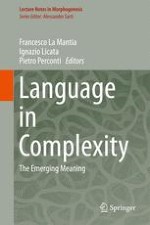
2017 | OriginalPaper | Buchkapitel
1. The Game of Complexity and Linguistic Theorization
verfasst von : David Piotrowski, Y.-M. Visetti
Erschienen in: Language in Complexity
Aktivieren Sie unsere intelligente Suche, um passende Fachinhalte oder Patente zu finden.
Wählen Sie Textabschnitte aus um mit Künstlicher Intelligenz passenden Patente zu finden. powered by
Markieren Sie Textabschnitte, um KI-gestützt weitere passende Inhalte zu finden. powered by